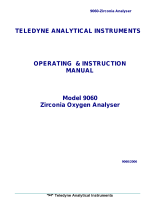
INM MTL 130-0183 Rev 6
iii
CONTENTS
DECLARATION OF CONFORMITY . . . . . . . . . . . . . . . . . . . . . . . . . . . . . . . . . . . . . . . . . . . . . . . . . . . . . . . . ii
1 INTRODUCTION ....................................................................1
1.1 General Description ........................................................................1
1.2 Manual symbols ...........................................................................1
1.3 Information ...............................................................................1
2 SPECIFICATION .....................................................................2
2.1 Display ...................................................................................2
2.2 Display ranges ............................................................................2
2.3 Display Resolution .........................................................................2
2.4 Accuracy .................................................................................2
2.5 Stability ..................................................................................2
2.6 Speed of response .........................................................................2
2.7 Sample flow ..............................................................................2
2.8 Sample inlet pressure ......................................................................2
2.9 Sampling system material ...................................................................2
2.10 Analogue output - isolated ...................................................................2
2.11 Alarm outputs .............................................................................2
2.12 Serial Communications .....................................................................3
2.13 Ambient operating temperature range ........................................................3
2.14 Power requirements ........................................................................3
2.15 Dimensions ...............................................................................3
2.16 Weight ...................................................................................3
3 INSTALLATION .....................................................................4
3.1 Mounting .................................................................................4
3.2 Sample. . . . . . . . . . . . . . . . . . . . . . . . . . . . . . . . . . . . . . . . . . . . . . . . . . . . . . . . . . . . . . . . . . . . . . . . . . . . . . . . . . .5
3.3 Electrical connections ......................................................................6
3.3.1 Power supply ..........................................................................6
3.3.2 Alarm and Analogue Output connections ...................................................6
3.3.3 Sensor Connection ......................................................................7
3.3.4 RS232 Connection ......................................................................7
4 COMMISIONING ....................................................................8
4.1 Applying power ...........................................................................8
4.2 Programming .............................................................................8
4.2.1 Analogue output .......................................................................8
4.2.2 Alarm 1 ...............................................................................9
4.2.3 Alarm 2 ...............................................................................9
4.3 Introducing the sample .....................................................................9
5 CALIBRATION ....................................................................11
5.1 Calibration overview ......................................................................11
5.2 Calibration gases .........................................................................11
5.3 Calibration gas piping and cylinder regulators .................................................11
5.4 Calibration procedure .....................................................................12
5.4.1 ‘High point’ calibration .................................................................12
5.4.2 ‘Low point’ calibration ..................................................................12
5.5 Maintenance .............................................................................12
6 SPARES AND REPAIRS ..............................................................13
7 TECHNICAL DESCRIPTION OF SENSOR ...............................................14
8 COMMUNICATION PROTOCOL .......................................................15
Table 1 - Common groups . . . . . . . . . . . . . . . . . . . . . . . . . . . . . . . . . . . . . . . . . . . . . . . . . . . . . . . . . . . . . 16/17
Table 2 - Error messages . . . . . . . . . . . . . . . . . . . . . . . . . . . . . . . . . . . . . . . . . . . . . . . . . . . . . . . . . . . 18

























